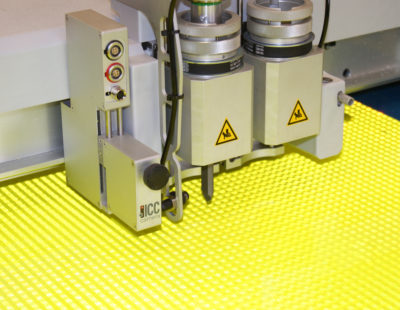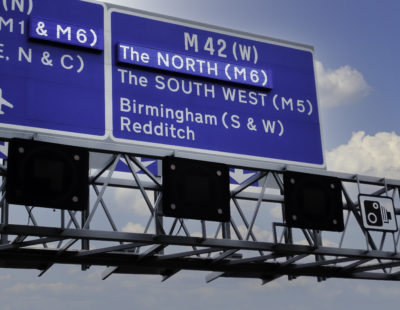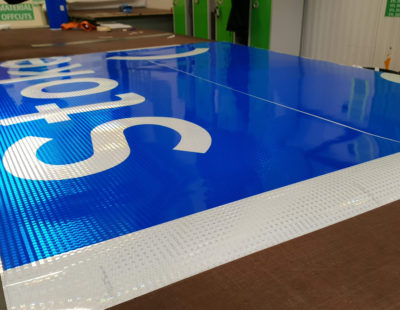For most road safety applications, micro prismatic reflective sheeting materials offer superior performance to glass bead products. Incorporating thousands of tiny prisms, these materials are capable of returning a larger proportion of the light that hits them, achieving better conspicuity in all conditions.
Lakeside Group has over 30 years’ experience supplying quality reflective materials to the traffic, pedestrian, and road safety industries. We know the power of micro prismatic reflective sheeting to create better and safer roads for all users, and are passionate about communicating its benefits.
In this blog, we provide an overview of micro prismatic reflective sheeting materials and their various applications.
What is micro prismatic reflective sheeting?
Micro prismatic reflective sheeting is a type of reflective sheeting that offers visibility superior to glass bead materials – particularly over long distances. This material is formed of thousands of acrylic or polycarbonate micro prisms embossed into layers with a mirrored backing. These prisms offer much better performance when it comes to returning light to its source, and have a wider angle of reflection. Micro prismatic materials also don’t disperse light as readily as glass bead products, but offer a focused, more direct light and brighter reflectivity.
Explore our full range of reflective materials >
Types of micro prismatic reflective sheeting
Air Gap
As the name suggests, air gap micro prismatic reflective sheeting materials incorporate gaps of air or ‘air cells’ into their construction. They are formed of an adhesive base layer, a backing film, with air gaps and a micro prismatic layer above. Due to the nature of the air gaps in the structure, they often require an edge seal to prevent the ingress of dirt and water.
Metallised
By contrast, metallised micro prismatic reflective sheeting materials have no air gaps – that’s why they’re also known as solid construction. They are made up of a single layer of micro prisms reinforced by an aluminium layer. With no gaps, they don’t require edge sealing and typically last for longer than air gap alternatives.
To find out more about air gap and metallised micro prismatic products, read our dedicated blog.
Classes of micro prismatic reflective sheeting
There are a number of classes or grades of reflective materials available on the market today, and the following are relevant to micro prismatic sheeting.
- – R1/RA1 – entry level engineering grade glass bead and micro prismatic materials.
- – R2/RA2 – this class also includes glass bead products alongside micro prismatic materials with a high level of light return. This class is normally specified for UK traffic signs.
- – R3B – for applications where the above class is not sufficient, R3B micro prismatic materials offer superior light return.
- – R3C – these micro prismatic materials are made using what is known as ‘full cube design’. This construction is designed to maximise light return, and offers the best performance on the market.
Learn more: What is Class R3C?
Micro prismatic reflective sheeting applications
Traffic signs
Permanent and temporary traffic signs alike often make use of quality micro prismatic reflective sheeting to ensure high levels of conspicuity in all conditions. For long distances, micro prismatic products offer better illumination over glass bead materials, but there are some circumstances where they are less preferable.
A Beginner’s Guide to Reflective Sheeting for Traffic Signs
Vehicle livery
From ambulances to police cars to construction fleets, micro prismatic reflective sheeting is often used to create highly conspicuous livery for an array of vehicles. Many businesses also choose to use micro prismatic materials to design eye-catching promotional markings for their company vehicles to boost brand awareness on the move.
Delineation/contour tape
Another application for micro prismatic reflective sheeting is delineation or contour tape, also known as ECE104 or conspicuity tape. Heavy Goods Vehicles (HGVs) often use micro prismatic reflective tape to make other road users aware of their full width and length at night. Road construction sites, likewise, utilise the material to demarcate the full extent of the works so vehicles can safely navigate around them.
Benefits of micro prismatic reflective sheeting
- – Superior light return – unlike lower grades of reflective sheeting, micro prismatic materials return the majority of the light that hits them back to their source, offering much higher performance for situations where visibility is particularly critical.
- – Visibility in all conditions – thanks to their high retroreflective performance, micro prismatic products are highly visible in all conditions. Whether at night, in a fog, or in the rain, vehicles and road signs incorporating this sheeting will always be easy to spot.
- – High conspicuity over long distances – it’s typically advised that applications requiring conspicuity over long distances opt for micro prismatic reflective sheeting. As this material returns a more focused light back to its source, less is dispersed and lost during travel.
- – Compliance with regulations – certain applications requiring reflective materials are governed by regulations and guidelines on the type and class of material to use. Micro prismatic reflective sheeting is generally preferred in most cases.
- – Enhanced road safety – above all, reflective materials exist to enhance road safety. By utilising micro prismatic reflective sheeting, you will be harnessing the power of the most advanced reflective technology on the market to cultivate safer roads for all.
Trusted supplier of micro prismatic reflective sheeting materials
Lakeside Group is an established supplier of quality micro prismatic reflective products to businesses and local authorities all over the UK. Working in partnership with market leading manufacturers, we offer a comprehensive range of reflective materials suitable for numerous applications.
Get in touch to talk through your requirements or explore our full range here.
Read next: What is a Retroreflective Material & How Does it Contribute to Road Safety?




